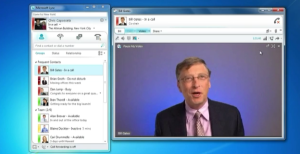 More than three years after acquiring Skype, Microsoft today said it would rebrand its semi-rival Lync corporate communications platform as “Skype for Business.”
More than three years after acquiring Skype, Microsoft today said it would rebrand its semi-rival Lync corporate communications platform as “Skype for Business.”The name change will become official in the first half of 2015, when Microsoft releases the next versions of Lync’s clients and on-premises server software as Skype for Business. The Lync service that’s part of some Office 365 commercial subscription plans – such as Business Premium ($12.50 per user per month) and Enterprise E3 ($20) – will also be updated and renamed at that time.
Microsoft’s using the same nomenclature for the new name as it has for other corporate offerings, including OneDrive for Business, and to emphasise more-than-consumer products, such as Office Home & Business 2013.
The rebranding comes more than three years after Microsoft acquired Skype for $8.5 billion. Since then, Microsoft has maintained two lines of instant messaging and video conferencing software – Skype for consumers and Lync for businesses – with the latter pitched as an inside-the-perimeter communications platform that also handles VoIP (voice over Internet protocol) telephony chores.
Although the two will continue to focus on different pools of users, Skype for Business will include some elements of the consumer-Skype user interface (UI) and expand the current Lync-Skype interoperability. Skype for Business customers will be able to reach Skype users not only for instant messaging chats and audio calls, but also for video calls, Microsoft said.
The new Skype for Business clients – now available on Windows and Windows Phone as well as rival OS’s including Android, iOS and OS X – will be accompanied by an update from Lync Server 2013 on the server side. The Lync backend for commercial Office 365 customers will be updated by Microsoft, as is usual for the subscription-based, semi-cloud-based plans.
It’s not surprising that Microsoft decided to drop Lync for Skype, said Jan Dawson, principal analyst, Jackdaw Research. “[The branding] was always one of the big questions after Microsoft acquired Skype. They’ve progressively talked about integrating the two so that they talked to each other, but they sat in different places, with different branding. Yet it always seemed logical. So this is the culmination [of the Skype acquisition]. What’s a surprise is that it’s taking as long as it has.”
Microsoft also hinted that Skype and Lync were destined for a closer relationship almost two years ago when it shifted the Lync team to the group responsible for Skype.
“This is also a recognition that the two are on a continuum, that people will use whatever tool makes the most sense to them at the time,” Dawson said.
That hews to CEO Satya Nadella’s push to define Microsoft as the “productivity” company, a message he hammered in July in a 3,100-word message to employees and one he stressed last week in an invite-only briefing with a handful of reporters, including ones from the New York Times and Fast Company.
“To me that’s the broadest definition of productivity, which is for us to empower individuals and organizations to be able to make things happen and get stuff done,” Nadella told the New York Times.
Microsoft’s Gurdeep Pall, who heads the Skype group, used a similar everything-everywhere message today while announcing Skype for Business. “Connecting people across all of life’s moments – to talk, to share, to collaborate – is at the heart of helping people make the most of every moment,” Pall wrote on the Skype blog.





